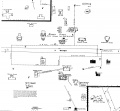Vermont Industrial School
| Vermont Industrial School | |
|---|---|
 | |
| Opened | 1874 |
| Closed | 1979 |
| Current Status | Closed |
| Building Style | Cottage Plan |
| Location | Vergennes, VT |
| Alternate Names |
|
History
The Vermont Industrial School was authorized by the state legislature in 1865 as the Vermont Reform School and soon put into operation in the town of Waterbury. The School was to aid in the reformation and correction of all offenders under eighteen years of age, changed to sixteen years in 1866. Prior to the establishment of this School, juveniles were treated the same as adults. The school was all but destroyed by fire in 1874, so the legislature appropriated $49,000 for it to move to the old Champlain Arsenal grounds in Vergennes, where it remained until it closed in April 1979. In 1875, permission was given to send girls from ages ten to fifteen to the school. The Vermont Reform School had its name changed in 1900 to the Vermont Industrial School, then in 1937 to the Weeks School in honor of former Governor John E. Weeks. The School was controlled by a three member commission until 1906 when it came under the Board of Penal Institutions. In the years between 1906 and 1966, the School underwent some changes in control. In 1966 Weeks School was administered by the Department of Institutions. When it closed in 1979, the School was under the jurisdiction of the Department of Corrections.
The institution played a role in the eugenics movement in Vermont. In 1925 Henry F. Perkins, professor of zoology at the University of Vermont, organized the Eugenic Survey of Vermont as an adjunct to his heredity course. Its mission was to conduct eugenics research, educate the public about the results of that research, and provide support for social legislation that would reduce the apparent growing population of Vermont’s “social problem group.” Professor Perkins reportedly brought his heredity class to Vermont Industrial School for “field work” in eugenics, and many of the Eugenics Survey’s genealogies of so called “degenerate” families originated with children at this institution.
Besides juvenile delinquents the school also served as a temporary shelter for children who were not delinquent, but were dependent or neglected children. In the 1960’s the school offered a strong developmental and educational program in a campus atmosphere. At that time the population was about 160 with seventy to ninety additional children in foster homes under the eye of the institution.
In the 1979 with the movement for deinstitutionalization and for centralization of human services functions, the federal government offered to take the Weeks School as a Job Corps site. Federal funds supported a transition to a community-based system of juvenile services, and the Departments of Corrections and Social and Rehabilitation Services used those funds to begin a network of group homes, open a secure detention unit at Waterbury State Hospital, and create a wilderness camp. The state transferred responsibility for children adjudicated delinquent to the Department of Social and Rehabilitation Services, which in turn contracted with community mental health centers, licensed group homes, schools, foster parents, and others for services formerly provided by state employees.
The federal government established a job corps program on the site.



